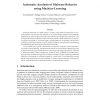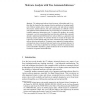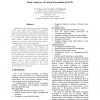151 search results - page 1 / 31 » Semantics-Aware Malware Detection |
SP
2005
IEEE
13 years 10 months ago
2005
IEEE
A malware detector is a system that attempts to determine whether a program has malicious intent. In order to evade detection, malware writers (hackers) frequently use obfuscation...
BWCCA
2010
12 years 11 months ago
2010
As the obfuscation is widely used by malware writers to evade antivirus scanners, so it becomes important to analyze how this technique is applied to malwares. This paper explores ...
JCS
2011
12 years 7 months ago
2011
Malicious software—so called malware—poses a major threat to the security of computer systems. The amount and diversity of its variants render classic security defenses ineffe...
CAV
2011
Springer
12 years 8 months ago
2011
Springer
Abstract. The underground malware-based economy is flourishing and it is evident that the classical ad-hoc signature detection methods are becoming insufficient. Malware authors ...
ACSAC
2004
IEEE
13 years 8 months ago
2004
IEEE
Software security assurance and malware (trojans, worms, and viruses, etc.) detection are important topics of information security. Software obfuscation, a general technique that ...



